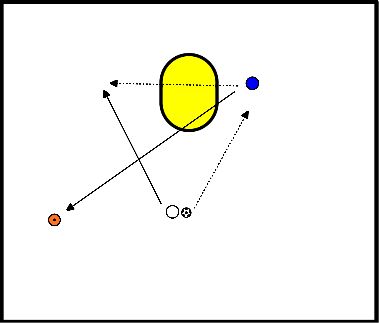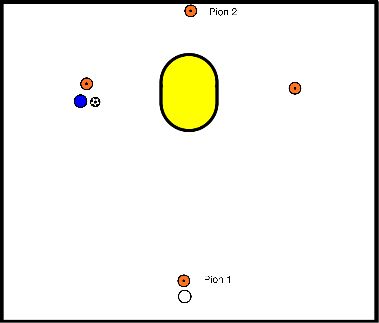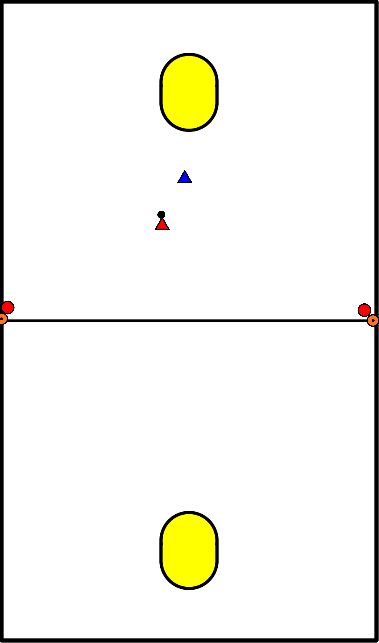Korfball drills for technique shoot / score / shot
- One player for one minute
- Place four hats around the basket at about 3/4 of a meter, one in front, one on the left, one on the right and one behind the basket.
- The shooter starts in front of the basket.
- The receiver stands with the ball under the basket.
- The active player receives the ball and shoots, then walks directly to the next pawn next to the basket. Walk left for 1 minute and shoot on the move at each pawn.
- After one minute, switch from catch to active player.
- Do the same but walk to the right.
Pairs:
- Number 1 with the ball starts in front of the basket.
- Number 2 stands left or right in front of the basket.
- Number 1 throws to number 2 and then pulls away to the side where number 2 is not standing.
- So number 2 is on the left side of the basket, number 1 walks to the right side of the basket.
- Number 2 throws the ball to number 1, after which number 1 shoots.
- Number 1 must catch his own ball.
- During the shot of number 1, number 2 sprints to the pawn, which is on a random spot on the field.
- Place on the pitch depends on the child's level.
- If number 1 hits the ball, he/she gets one point, if number 1 catches the ball before number 2 reaches the cone, number 1 also gets one point.
- so possibility of getting 2 points
- Change function.
- The first to get 6 points wins (variation possible).
- Is the sprinting too easy: add an extra pawn, which increases the sprint distance and for example makes a fast turn.

- At pawn 1
- touch the groundTouch the ground, jump up and stretch all the way. We do this 10 times.
- RUN TO THE POLE.
- Pole
- next you take a dodge at the pole.
- RUN TO PAWN 2.
- Pole 2
- 5 sit ups.
- RUN TO POLE
- Pole
- take a run through at the pole from behind the basket
- RUN TO PAWN 1
- Pawn 1
- Push-ups 5 times
- RUN TO POLE
- Pole
- Take the penalty throw
- RUN TO PAWN 2
- Pole 2
- Shot four meters behind the basket
- After the intercepted shot, receive the ball and throw it back to the receiver, who is standing next to the basket.
- Sprint to pion 1 and start again
- We do this 3 times
- Keep the post clear and keep your distance from each other.
- But each time change under the post.

- You have two attackers on the side in the middle between two baskets.
- The attacker must try to score with the help of the two players.
- At an interception, the defender becomes the attacker.
- When a goal is scored, the attacker gets a bonus and is allowed to keep attacking, only now he has to attack the other basket.
- When three goals have been scored, the winning attacker is rested and exchanged with a declarer.

In short: practicing various shooting variants in a fun competition form.
- Organization: per group a basket and a ball, the baskets are preferably (but not necessary) arranged in a circle or rectangle.
- The number of persons per group is less important (but all groups are about the same size).
- The first assignment for the groups is: score 10 goals.
- When you have completed this assignment, the person who scored the last goal runs to the trainer to pick up the next assignment.
- Which group completed all assignments first?
- The trainer walks around, encouraging, or correcting.
- He has a piece of paper with him with a row of assignments on it.
- When someone comes to pick up the next assignment, first ask which one has just been done (this can vary considerably over time) and then hand out the next assignment.
- An example list: 10 walk-through balls, 15 penalty shots, 5 8-meter shots, 10 walk-through balls from behind the basket, 5 dodge balls next to the pole, 10 6-meter shots.
- Everything is possible of course, a lot of momentum is gained if the number of goals to be scored is kept small.
- 10 walk-through balls
- 20 small oppertunities
- 6 remote shots
- 10 penalty throws
- 1 backwards
- Three at a basket
- Two shooters in front of the basket at shooting distance 4-6 metres, one rebounder under the basket.
- The shooters take turns shooting, whoever scores first can stay at the basket.
- The losing shooter changes to the rebounder and the new battle begins.
- Option: The shooter who scores three goals first may remain standing.
- Option: In foursomes, you have two teams (one shooter, one rebounder), the losing team switches positions between them.
- One shooter.
- Two catchers.
- Two balls.
- The shooter shoots from an easy distance.
- Because two balls are used, the pace of shooting is high.
- The goal is not to get sloppy but to keep shooting technically and to "automate" the shot.
- You can vary with locations or types of shot (short/distance/shot-through) and so on.
- In this exercise you have two helpers, each with a ball and a shooter.
- Around the pole there are pawns of different colours.
- The shooter then makes an action towards that colour and shoots.
- After X goals, the players change roles.
- Attention:
- The player must be turned in to shoot
- The player must always look at the ball
- Quickly take the shot
- 4 against 4.
- Pay attention to the basic set-up, to the ball pace and to the movement of the players, so that there is not just one attacker moving.
- Make the game more surprising by moving the ball, pulling the ball away, throwing it deep, etc.
- In two groups you are going to shoot.
- 1 person is going to shoot, 1 catch, 1 hoop
- The person is going to shoot
- At every goal the person who takes the hoop, takes a hoop and puts it over the shooter.
- The shooter has to stand there until someone has scored.
- This way you keep on turning.
- When there are no more hoops you change from basket.
- Who has the most after 5 minutes, has won.
- Practicing throwing and releasing on the short and long line.
- The declarer stands far from the basket. The archer stands in front of the box at the side of the declarer.
- The archer walks up to the declarer (the short line), receives the ball and shoots.
- The declarer becomes a shooter, the shooter walks to behind the basket, the catcher arrives at the position of the declarer, after the ball is thrown to the next declarer.
Variant:
- The shooter chooses the long line after feinting towards the short line or basket.
- Both variations can be trained with the opponent near the shooter, so that the declarer learns to judge when someone is free.
- Dose the defender. When using a defender, the 2nd declarer (who in fact does nothing) can act as a defender.
- The rotation after the exercise is: declarer becomes defender, defender becomes gunner, gunner becomes catcher and catcher becomes declarer (after a combination with a player).
- Practicing throwing and releasing on the short and long line.
- The declarer stands far from the basket. The archer stands in front of the box at the side of the declarer.
- The archer walks up to the declarer (the short line), receives the ball and shoots.
- The declarer becomes a shooter, the shooter walks to behind the basket, the catcher arrives at the position of the declarer, after the ball is thrown to the next declarer.
Variant:
- The shooter chooses the long line after feinting towards the short line or basket.
- Both variations can be trained with the opponent near the shooter, so that the declarer learns to judge when someone is free.
- Dose the defender. When using a defender, the 2nd declarer (who in fact does nothing) can act as a defender.
- The rotation after the exercise is: declarer becomes defender, defender becomes gunner, gunner becomes catcher and catcher becomes declarer (after a combination with a player).







